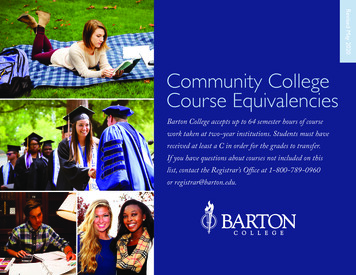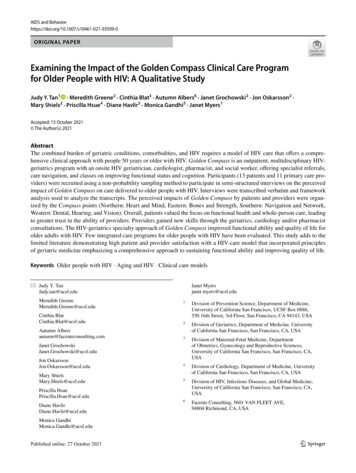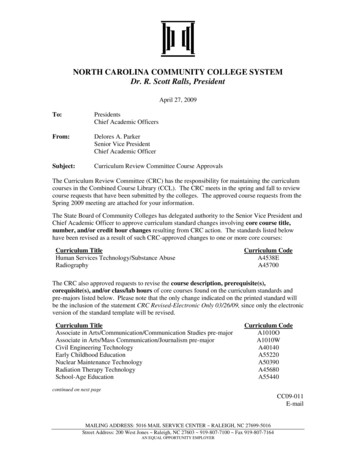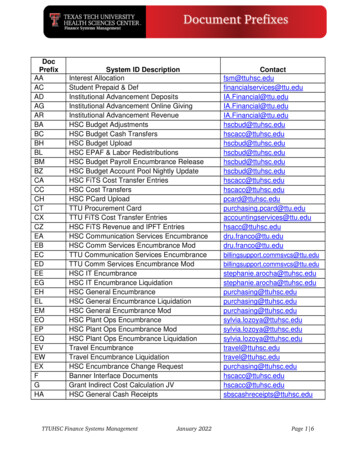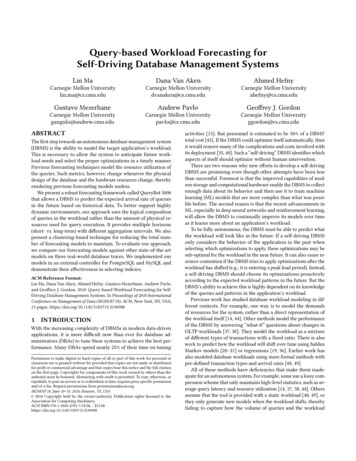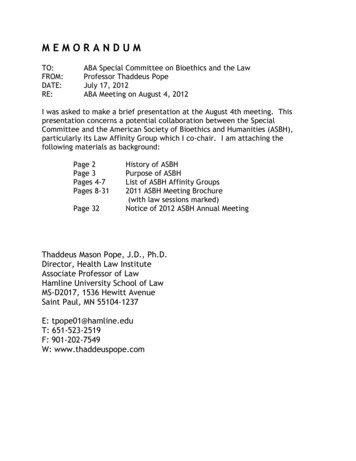
Transcription
CN EDU C TI Nt ofbmittethe rWire eMaster0gree fonavis J. CorsTe, TS.Tasma a C liege fJanu try 1979earl n
TABLE OF CONTENTSAbstract4Introduction6PART ONE : "NOAM CHOMSKY AND CONTEMPORARY ATTITUDES TO LANGUAGE"- A Brief Overview10Reference Notes and Bibliography ; Part One18PART TWO : "LANGUAGE AND MIND" to "AMERICAN POWER. "202.1Language and Mind222.2American Power and the New Mandarins302.3Relevant Published Papers 1968-196939PART THREE : "AT WAR." to "PROBLEMS."423.1At War With Asia443.2Problems of Knowledge and Freedom543.3Relevant Published Papers 1970 - 197260ERRATATable of ContentsAppendix - Extracted for Extrapolated.2. Abstract1.24Extracted for Extrapolated.3. Introduction page 31.284. AppendixheadingExtracted for Extrapolated.page 134Extracted for Extrapolated.
PART FOUR : "FOR REASONS OF STATE" to "REFLECTIONS"4.1For Reasons of State4.2Counter-Revolutionary Violence4.3Peace in the Middle East?4.4Logical Structure of Linguistic Theory4.5Reflections On Language4.6Relevant Published Papers 1973 - 19766668140801438292PART FIVE : "CHOMSKY ON EDUCATION" - A Collation of Attitudes1045.1The Nature of Education1065.2Native Language Education1075.3 Second Language Education1095.4Education for Work - Further Education1115.5University and Higher Education1135.6Education in Developing Countries andEducation for Liberation .1155.7Educational Psychology1165.8Political Education1185.9Curriculum Design and Methodology1205.10Educational Policies1225.11Educational Philosophy1235.12The Congruity and Genesis of Chomsky on Education.125Reference Notes: Part Five130Appendix; Extrapolated Incidental References132Bibliography148
t
ABSTRACTThere are no published books by Noam Chomsky which concern themselveswith education or which are written with educationists in mind as theintended and specific audience. Of his many published articles, only oneshort paper deals specifically with some of his views on education, and,even here, mainly in the general philosophical terms of the humanisticconception of education. Yet Chomsky's influence on courses of teachertraining and on the teaching of language, by any standard, is immense. Atthe same time it would be reasonable to assume that the classroom teacherhas only a vague impression of Chomsky's significance for education.What are his attitudes towards those areas of education to which hehas directly contributed? To what other areas has he turned his attentionand how has he attempted to influence them indirectly through his writings?.To what extent do his published writings reveal his attitudes towardpedagogy?Ishis philosophyof education clearly and cogently revealedin his works? What can be deduced about his attitudes to the "institution"Are his attitudes consistent and(in a sociological sense) of education?do they have a common source?This study explores each text and published paper of ChomsKy,fromhis most productive and diversified period, in order to extrapolate allreferences to education, as defined within certain narrow and exclusive limits.The period selected, the method of extrapolation and the definitiveboundaries applied, are discussed more fully in the INTRODUCTION whichfollows.From each extrapolated reference, wherever it is more than incidental,and from its context, inferences are made which comment upon and try toreveal Chomsky's attitudes to education, as it is narrowly and exclusivelydefined in the INTRODUCTION.Part One of the study briefly describes Chomsky's place in thatdisciplinary area where he has made his most notable contributions;theoretical linguistics and linguistic philosophy. Each of Parts Two,-Three and Four deals with a chronological period, extrapolating referencesfrom all the published works which have relevance in the terms of thisstudy. Part Five collates and categorises the many attitudes inferredand discussed in Parts Two to Four.
INTRODUCTIONLanguage and Mind, published in 1968, stands as a watershed inthe published writings of Noam Chomsky. According to George SteinerLanguage and Mind'epresents a summary of generative linguistics andExt/taa program for future work" ("Tongues of Men", an extract fromtelotitoat-Popms on Liteltatulte and the Language Revotution). For thesereasons, this book and 1968 have been chosen as the beginning point forthis study.Regection4 0in Language ; published in 1976, marks theendpoint of the period covered, a suitable climax since this recent bookdeals with many of the issues raised inLanguage and Mind and concentrates,as did the latter. in its revised form, on both theoretical linguisticsand philosophy of language.Prior toLanguage and Mind, Chomsky's six published books fromSyntactic StAuctuke6 to Sound Pattekn o6 Engtizh are relatively homogeneous in subject matter. They deal, in the main, with theoreticallinguistics and linguistie philosophy, as do his published articlesfrom this period. In the nine year period from 1968 to 1976 however,Chomsky's range of published commentaries expanded radically and hisoutput increased commensurately.Of the eleven titles published during this period, two deal specificallywith theoretical linguistics, three with the philosophy of language,linguistics and general philosophical themes, one with the Middle Eastand international affairs, and five with American foreign policy,particularly in relation to the Vietnam War. Of the twentyeight articlespublished between 1968 and 1976, only eleven deal with subjects strictlyrelevant to Chomsky's academic disciplines. The remainder cover topicsof national and international affairs and, matching the inclination of sixof the relevant books, are strongly polemical, in tone.The works from the period selected, then, reveal Chomsky as anintellectual, an educationist, a citizen of the world and a polemicist.They seem to offer the range of comment required for such a study as this.The reader, can gauge from the study itself how wide and detailed is therelevant information resident in the works used.The study extrapolates and makes deductions from all and any references
to education in the published works of the period. The following narrowand exclusive limitscontrol the selection of citations for extrapolation.For the purposes of this study, education refers to the specific socialact of one relatively active, purposeful individual or collectivity ofsuch individuals engaging specifically in the training, instruction orteaching of another relatively passive individual or collectivity of suchindividuals. This narrow and exclusive definition only admits intoconsideration, within the study, references made by Chomsky, or quotedby him, which include one or other of the following words or words cognateto the following words: "education", "training", "instruction", "teaching".This definition excludes references which contain literary or metaphoricalterms which could be synonymous with the above ("nourish", "graft" or"enlighten", for example), which are of a type not used by Chomsky in anycase. More particularly, this definition excludes any reference whichcentres on the word "learn" or on one of its cognate forms, since, whilethe 'activeness' or 'passiveness' of the activity described by this wordis a central point of issue in Chomsky's work, his use of the word "learn"in general is not strictly relevant to the words teach, instruct, educateor train. As well any reference to one of the four above-mentioned words(or cognate words) is ignored if, in a semantic sense, its 6oAm ratherthan its meaning is stressed.A simple method is used for treating each citation, or, in manycases, a number of citations treated collectively. There are four stepsin this method:(a) cite as a reference by underlining the word or phraseas part of its sentence (several sentences in manyinstances), editing passages where necessary for reasonsof space.(b) set the reference within its textual context by quotingits Chapter heading, page, article or number.(c) set the reference within its sense context by conciselyexplaining what Chomsky is discussing when he refers tothe Cited word or phrase and how it relates to his argument.(d) deduce,if possible, what the reference and its contextreveal about Chomsky's attitudes to education, as it isnarrowly and exclusively defined above.Many citations are incidental to the purpose of this study. These
have been removed from the body of the text to an appendix. Theyare indicated by the phrase INCIDENTAL REFERENCE ONLY appearing, at (c) or sometimes (d). This phrase indicates that the citation istrivial, superfluous or incidental. Usually there is no sense contextdelineated for these references, unless they happen to be used in aquotation by Chomsky, in which case the source of the quote isroutinely identified. There are, of course, no deductions at (d)for these incidental references.Part Five collates and categorises the many attitudes deduced,under headings which are helpful for appreciating the range ofChomsky's comment and the relevance and coherency of his views. Theseinterpretations in summary are referenced by footnote back to theirprimary sources.Two facts which this work well illustrates are that Chomsky'sintellectual interests are diverse and that they lead him to considereducation from many different angles. It is necessary here to drawattention to an important and concluding section in Part Five of thestudy entitled "The Congruity and Genesis of Chomsky On Education."This key section offers attempted answers to questions which go beyond theassembling of inferred attitudes. The section discusses the internalconsistency of Chomsky's views in an effort to trace them back to somecommon source, if possible, or to show inconsistency if necessary. Italso examines Chomsky's views on education as revealed in his polemicalwritings and compares them with the implications he has drawn for educationas a result of his more formal and more publicly reasoned academic work onlanguage.A comment on the suitability of the approach and of the methodologyused is appropriate here. Of the 322 citations identified and extrapolatedno less than 276 were valuable for providing inferential material. Ofthese 62 re-covered similar ground to others, but still added weightto deductions and demonstrated Chomsky's attitudinal consistency. Only46incidentat fr e6enence4were extrapolated. Furthermore, the successof the terminological constraints employed was apparent during thecourse of extrapolation, since no major section in the many books andarticles covered, giving worthwhile insights into Chomsky's attitudesto education, was by-passed on the grounds that it could not bediscussed within the conceptual limits of the study. This remarkablefact is a tribute to the exactitude of Chomsky's language use. Themethod suits Chomsky, but it could not be recommended as an approach foranalysing the works of all writers:
The Bibliography includes an introdusctory note explainingsome features of classification peculiar to it. Part One, whichgives some brief background to Chomsky's contributions within his'academic discipline, has its own Bibliography included as part'ofits Reference Notes on page 18. This section is intended to standapart. The rest of the work deals with primary sources only.
PART ONE"NOAM CHOMSKY AND CONTEMPORARYATTITUDES TO LANGUAGE"- A BRIEF OVERVIEW
1.1It would seem that since his celebrated review of B.F. Skinner'sVerbal Behaviour in 1959, in which he claimed that the behaviourists'impressive panoply of scientific terminology and statistics was nomore than camouflage, covering up their inability to account forthe fact that language simply is not a set of habits, Chomsky's pointof view on the nature of language acquisition has become progressivelythe general attitude on the matter. The major point which flows fromhisrebuttal of the behaviourists' approach to explaining the manner oflanguage acquisition is "that there are apparently deep-seated andrather abstract principles of a very general nature that determinethe form and interpretation of sentences" and that "it is reasonableto formulate the empirical hypothesis that such principles are languageuniversals.The modern attitude is clear, according to Lyons, whoclaims that "what his theory of generative grammar seeks to formalise rule-governed, structure-dependent, creativity whose complexity isdefined by the power of the grammar - is certainly an essential part„2of language.Moreover Chomsky has given more than good reason tobelieve that the model of stimulus-response is incapable of accountingfor all facets of language behaviour. When Chomsky says that thegrammar of a particular language is a system of rules and principlesthat links sound with meaning, he is taking for granted the nativespeaker's ability to perform another kind of interpretation, by meansof which the phonetic representations are converted into sound and thesemantic representations into meaning. The missing links are suppliedby the more general theory of grammar which Chomsky refers to as"universal grammar”. It is by virtue of his knowledge of universalgrammar that the speaker of a natural language is held to be able tointerpret the phonetic and semantic representations. What follows isan analysis of contemporary attitudes to Chomsky's theory of grammarAichhas been undoubtedly the most dynamic and influential and in relationto which every other school of linguistics tends to define its positionon particular issues. The modern attitudes will be explored underthree headings: phonology, syntax and semantics.1.2Phonology, which deals with the sounds of language and the notionthat sentences can be represented as sequences of phonemes, is seenas crucial to any modern theory of grammar.12
Chomsky allows the possibility that it may become clear thatthe principles of phonology are considerably more sophisticatedand intricate than those of semantics and that phonology may become3.a far deeper theory than the already profound theories of semantics.4Elsewhere he notes that the study of language, since the pioneering worof Ferdinand de Saussure, has revealed that the sounds of language enterinto systematic relations in accordance with restrictive principles.It is in the doMain of mapping abstract sound patterns in accordancewith ordered rules of a narrowly defined type to produce a physicalstructure unlike the underlying mental representation, that recentstudies have yielded clarity of insight.As the method of entry into the encoder's message, phonologicstructure must be analysed first and links found with syntax. Ingeneral the relation between phonology and semantics is indirect, beingmediated by syntax, but two areas reveal more direct links. These are5contrastive stress and sound symbolism, according to Lyons .The most recent attempt at a grammatically oriented phonologyknown as generative phonology, owes much to Sapir, as is expresslyindicated by its leading proponents, Noam Chomsk; and Morris Halle. 6This extends the parallelism between semantics and syntax also tophonology. The theory has been guided by the principle of a set ofrules connecting deep phonology (or "phonological representation")with surface phonology , (or "phonetic representation"). The link betweenthe two representations - phonological and phonetic - is estabTishedby a set of rules which operate in a fixed order, adding, deleting ormodifying distinctive features. According to Chomsky:These rules fall into various categoriesand exhibit invariant properties that areby no means necessary for a system of thoughtor communication. . 7For example it is held8that there is a fixed set of upto twenty distinctive features of phonology, and that, while notall of these will be found in the phonemes of all languages, everylanguage will make its own selection from the various possiblecombinations. Chomsky has called these phonological elements the"substantive universals" of linguistic theory, a name applied alsoto their syntactic and semantic equivalents.13
In this area at least Chomsky reveals his training in the Bloomfieldianschool of linguistics, against which, on most issues, he reacted. TheBloomfieldian view on this issue differs from the Chomskyan only inattitude, not substance. Bloomfield and his disciples, followingthe example of Boas, stressed the diversity of human languages, whileChomsky emphasises their similarities. At the same time, however,(and this draws them together) he admits that "universals" may beabsent in some one or other of very many quite familiar languages.It is relevant to point out here that Chomsky in his attitudes towardslanguage owes much to Sapir who took a more humanistic view of language,laying great stress on its cultural importance, and on the fact thatlanguage is 'purely human' and 'non instinctive'. 91.3Contemporary and stable attitudes to Syntax are hard toidentify since this area of language is infected with a dynamic onlyrivalled by Semantics. To describe Chomskyan attitudes in this areais not enough since the post-Chomskyan variants are more than subtlein the range of their diversity.In Syntactic Structures in 1957 Chomsky introduced thetool "transformational grammar" which has as one of its majoradvantages the capacity to enable us to relate superficially distinctsentences and distinguish superficially identical sentences. Thiscontrasted with "phrase structure grammar" by being more simple(according to Chomsky) since it uses relatively few but more complexrules, while phrase structure has many more' and less complex rules.Developing and refining transformational grammar Chomsky made anumber of modifications in 1965 in his standard theory in Aspects ofthe Theory of Syntax.Here he sees grammar in its widest sense toconsist of three levels and three set rules; the phonological,the syntactic and the semantic. To the point in this discussion,the syntactic rules "generate" the sentences of the language andthere is an independent level of syntactic deep structure. This verycomplex system includes rules of the base and transformations, theformer generating the deep structures. The transformational rules aretherefore "interpretive". To summarise, at this stage syntax is anindependent part of a linguistic description, divided into deep andsurface structures with the former providing the exclusive basisfor semantic interpretation, the next stage in the three tiereddescription.14
Since 1965 a range of "grammars" has appeared, the mostdistinctively post-Chomskyan challenge to Chomsky's standard theory'coming from "case grammar", which owes much of its inspiration nodoubt to the morphological study of inflected languages such as Latinand Greek. It relates the inflected postpositions of some languageswith the prepositions of others ( e.g. English), giving the verb itsproper place of importance in the sentence. The verb governs a set ofobligatory or deep structure cases which are filled by expressionsthat may occur as subjects, objects or prepositional phrases at amore superficial level. "Case grammar" has a number of attractionssuch as its identifiability across languages, its psychological relationto the acquisition of language by children and its semantic relevance,however it is not seen as a viable alternative to the standard theory.Next in importance "valency grammars", which have been more extensivelydiscussed in Germany and Russia, again centre on the verb as thegoverning element which determines the range and type of its dependentexpressions. "Relational grammar" attaches importance to the grammdticarelations of being subject, object or indirect object of the sentence,and is concerned with transformational correspondence between activeand passive sentences. According to Lyons l it has.not yet (1977) beenwidely exemplified in the published literature.Chomsky's "extended standard theory" has been in a stateof continuous development for the last ten years. In his 1976published work, Reflections on Language, Chomsky does much more thananalyse and describe his developing grammar. He looks at the controvers04E.among and between psychologists, philosophers and linguists, theinteraction of language with mental organs, and he suggests once againthat the conception of man as totally malleable is a false and dangerousone. In relation to syntax, words are allocated a deep structurerepresentation distinct from their semantic representation, as in hisstandard theory, but no longer does he see only the deep structure ofthe sentence as relevant to the determination of its semantic11representation.Now, as well, surface structures contribute in adefinite way to semantic interpretation:15
In this theory then the syntactic and semanticproperties of the former 'deep structures' aredissociated. Either class of properties might,then, be taken as defining the technical notion'deep structure'12 . we must now understandthe terms "basic structure" and "deep grammar"to refer to non-superficial aspects of surfacestructure, the rules that generate surface structures,the abstract level of initial phrase markers, theprinciples that govern the organisation of grammarand that relate surface structure to semantic representations, and so on.131.4Writing in 1964F. H. George described Semantics as being14In the next 10 years there was a move away"at the crossroads".from a view of semantics as "a messy, largely unstructured intellectualno-man's land on the fringes of linguistics, and a tendency to accord15to it a more and more central position in linguistic studies.That Semantics was ignored for so long as an area of legitimatelinguistic enquiry was due largely to the influence of Bloomfield inthe 1930's. His view was that the analysis of meaning was the "weakpoint in language study." Bloomfield in 1933, and another structurallinguist, Harris in 1951, did not see semantics as part of a linguisticdescription, although the former showed distinct interest in the area,devoting two full chapters in his Language to the topic and almostcontradicting his stated view when he claimed "to study this coordination16of certain sounds with certain meanings is to study language.Bloomfield and Harris in this area also influenced Chomsky'searly work. In his earliest published version of transformationalgrammar, Syntactic Structures meaning was in effect ignored and theindependence of form and meaning was maintained. Following Katz andFodor in The Structure of a Semantic Theory in 1963 the history oftransformational grammar has been broadly,a matter of conceding tosemantics a more and more important position in linguistic theory.Katz' paper, Semantic Theory,17restates this position, which hasas its lower bound that a semantic theory is determined by examiningthose abilities or capacities which all fluent speakers of a languageshare and which cannot be accounted for by the syntactic componentalone. This procedure is based on the assumption that "synchroniclinguistic description minus semantics equals grammar."16
Katz and Postal, in 1964, introduced the assumption thatsingulary transformations do not change meaning. With Chomsky in1965, they regard semantics as interpretive and that this interpretationis based exclusively on deep structure via projection rules in the sameway as phonetic interpretation is based on surface structure viaphonological rules. Thus there is left a symmetrical model of thegrammar with the transformational rules operating between the deepand surface structure.The position of Generative Semantics falls within the lastand most modern period of generative-transformational theory. Lakoff,Fillmore and McCawley propose quite drastic revisions of Chomsky's1965 model by declaring that the deep structure of a'sentence is sodeep as to be identical with its semantic representation. This nowmeans that the base component, in Chomsky's 1965 sense, is no longersyntactic but semantic and that projection rules are no longer needed.18Chomsky!s view, the interpretive one, now seems to occupy a minorityposition in regard to these issues. According to Leech the strOngestarguments on both the interpretive and generative sides have beenarguments against the rival position, rather than' in favour of theirown. He advocates a compromise position of deep arid surface semantics,deep and surface syntax and deep and surface phonology with transformatio(nrules operating at each level. This model he calls "Generative Semanticswith Deep Syntactic Structure", and his arguments for it, while toodetailed to go into here, are compelling.While the debate is far from concluded it would seem thatChomsky's recent position (1976) is approaching that of his rivals:There is a wide-spread feeling that semanticsis that part of language that is really deep andimportant, and that the study of language is interestingprimarily insofar as it contributes to some understandinof those questions of real profundity. .there is somemerit to this view. 1 917
REFERENCE NOTES AND BIBLIOGRAPHY: PART ONE1la."Review of B.F. Skinner, Vetbat Behavioue Language 35, (1959) 26-58Chomsky, Noam Problems of Knowledge and Freedom Fontana 1972, page 402.Lyons, John Chomsky Fontana Modern Masters 1977, page 1453.Lyons, op.cit. page 1034.Chomsky, op. cit. page 285.Lyons, John (ed) New Horizons in Linguistics Pelican 1970, page 946.Chomsky and Halle The Sound Pattern of English N.Y., 1968 page 767.Chomsky, Problems. page 298.Lyons, Chomsky page 1289.IBID page 3010.IBID page 9011.Chomsky, Reflections On Language Temple Smith 1976, page 81-8212.IBID page 8213.IBID page 8414.George, F.H. Semantics E.U.P. 1964, page 16515.Leech, Geoffrey Semantics Pelican 1974, pager-16.Steinberg and Jakobovits Semantics C.U.P. 1971, page 16817.IBID page 29718.Leech, op. cit. page 330;and Steinberg op. cit. page 17619.Chomsky, Reflections. page 8218
TWOPART"LANGUAGE AND MIND"TO"AMERICAN .POWER."
2.1LANGUAGE AND MIND( 1968, enlarged 1972 )- Harcourt Brace Jovanovich2.1.1.(a) This disability, says Huarte, "resemblesthat of Eunuchs, incapable of generation".Under these sad circumstances, in which theintelligence can only receive stimuli transmittedby sense and associate them with one another,true education is of course impossible, since theideas and principles that permit the growth ofknowledge and understanding are lacking.(b) Chapter "Linguistic Contributions : Past" page 10.(c) Chomsky outlines the historical roots of linguistic theory, beginningin the late sixteenth century with the Spanish physician Juan Huarte.Huarte distinguishes three levels of wit; docile wit, normal humanintelligence and creative imagination which surpasses normalintelligence. To have one's wit confined to the lowest of these,docile wit, is a serious disability since it is constrained byempiricist principles and makes the acquisition and demonstration oflanguage-impossible, even under the most diverse of stimuli.(d) This reference of Chomsky (and presumably of Huarte as well) to "trueeducation" argues that, for it to occur, a higher level of intelligencethan simply docile wit is needed. "True education" excludes the beastsand any human or animal creature which can only associate stimulus withresponse. "True education" requires students who, assisted by thecatalyst of the subject alone, can produce a range of independentlydevised and novel associations because their intelligence is capable ofgenerating new thoughts which are expressed in a form quite distinctfrom any training or experience. For education to occur, ideas andprinciples, not provided by training, must be resident in the intellect.In relation to language, only those equipped beyond docile wit can beexcited "to bring forth anything". It can' be concluded that onlyeducation which takes cognizance of the innate capacities of the witcan be described as "true education".2.1.2.(a) A largely irrational objection to explanatorytheories as such has made it difficult for modernlinguistics to appreciate what was actually at stakein these developments and has led to a confusion ofphilosophical grammar with the effort to teach bettermanners to a rising middle class.
(b)Chapter "Linguistic Contributions : Past" page 15(c)"Philosophical grammar", as the first really important general , theoryof linguistic structure, is under discussion. Chomsky mentions anumber of modern distorted references and misinterpretations of thisseventeenth century development. He seeks to rebut the charge of"prescriptivism" which was wrongly laid against philosophical grammar.Part of this charge was that its aim was merely to educate people tospeak in an acceptable manner. Its true function is comparable tocurrent generative grammar and other grammars which combine a deepand surface structure.(d)It may be possible to infer, from this rather incidental reference, aChomskyan view that there is no place in general education for theteaching of aspects of generative grammar, since he points out itsconnections with philosophical grammar and refutes the slight that thelatter was merely associated in its day with public education. This iscontrary to modern erroneous claims that it was used to introducesocially mobile folk into the linguistic conventions and other folkwaysof the upper class. Chomsky does not cite the source of these erroneousclaims. . .2.1.3.(a) Insofar as behavioural psychology has beenapplied to education or therapy, it has correspondingly limited itself to this concept of 'whatis learned".(b)Chapter "Linguistic Contributions : Future" page 72.(c)Chomsky argues that linguistic competence, which he defines as knowledgeof a language, must be seen as an abstract arrangement underlyingbehaviour, consisting of rules which determine the form and intrinsicmeaning of an infinity of sentences. The system which these rulescombine to form is a generative grammar. There are many such grammarsand they include idiosyncratic elements and other general universalelements. He discusses here potential areas of
The Bibliography includes an introdusctory note explaining some features of classification peculiar to it. Part One, which gives some brief background to Chomsky's contributions within his 'academic discipline, has its own Bibliography included as part'of its Reference N

